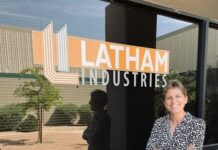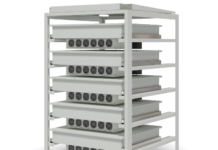
Broomfield’s Ball Aerospace marks its 60th anniversary Saturday, and it would be hard to overstate its importance both in the evolution of the United States’ aerospace industry, man’s exploration of the cosmos and the vitality of the scientific and technology community here in Boulder County.
Ball’s achievements in aerospace research are nothing short of astronomical, particularly for a company that sprung as a spin-off from the manufacture of glass jars.
A critical role was played by Ball in all four of NASA’s Great Observatories, the Hubble Space Telescope, the Chandra X-Ray Observatory, the Spitzer Space Telescope as well as the Compton Gamma Ray Observatory .
Ball built the instruments and spacecraft for NASA’s CloudSat and Calipso missions, which marked 10 years in orbit this year, although both of those missions were only designed for three-year program lives.
Additionally, Ball products are hosted on hundreds of air, ground and sea platforms, used by all branches of the U.S. Armed Forces.
With almost 1,700 employees across Colorado since its founding in 1956, Ball has become an indispensable partner to a long roster of institutions public and private, including the University of Colorado and other major universities around the state.
“I can’t say too much about how important Ball’s contribution to space astronomy has been, not just Hubble, but the James Webb Space Telescope,” said University of Colorado professor of astrophysics Michael Shull.
“I think their niche — and it’s a great niche — they are willing to partner with universities to build instruments to go on NASA facilities, not just Hubble and Webb but also the Explorers.”
Shull also made mention of the fact that “They hire a lot of our students. A lot of our undergraduates and graduates, now work at Ball, and it helps that they all want to come back to Boulder. “
Southwest Research Institute’s Alan Stern, principal investigator on the historic New Horizons flyby of Pluto in 2015. Ball built Ralph, a key component of the spacecraft’s seven-instrument payload featuring a multispectral imaging camera. Stern sees Ball as a critical piece of the aerospace economy in Colorado, the nation’s second-largest.
“Ball Aerospace has long been a major Colorado and Boulder brand, and a recognized leader and innovator without peer for its size in the aerospace industry,” Stern said in an email.
“Ball built the most important instrument, with the main camera-spectrometer suite, for NASA’s historic New Horizons mission that explored Pluto and its moons for the first time in 2015. Without Ball, the New Horizons proposal to explore Pluto might not have succeeded, and without that instrument, the scientific return from New Horizons would have been very much diminished.”
Leader of entrepreneurial community
It’s lofty territory for a company born of a meeting over beers in a Chautauqua Park neighborhood between Edmund Ball, a son of one of the five Ball brothers, who was looking to diversify the family’s glass manufacturing business, and CU physicist David Stacey.
Stacey, a year before Sputnik sparked the space race in 1956, was working with CU colleagues to develop a device for an optical spectrograph enabling instruments to be accurately pointed at fixed objects in the sky. It was a development that, according to unofficial Ball historian Robert Arentz, would profoundly change rocket science.
Ball was sufficiently intrigued to buy the rights to the instrument, along with hiring several employees, including Stacey, for a new company that would be called Ball Brothers Research Corp.
At the time Stacey worked for what was then called CU’s Upper Air Lab, an entity that would become CU’s Laboratory for Atmospheric and Space Physics
“I like to think of Ball as one of the paragons of our entrepreneurial community,” said John Tayer, president and CEO of the Boulder Chamber of Commerce.
“It was one of the original tech transfers out of the University of Colorado. And through the innovation of great technology that they developed over time. It has grown and become one of the most critical technology companies in our community, one of the foundational technological companies in our community.”
Tayer said Ball’s footprint as an economic engine in the community is not the only way in which it is an asset.
“They are also great community partners, supporting many of the local nonprofits and community interests,” Tayer said. “It’s the kid of organization that Boulder is proud to have birthed, and housed, through all its various stages of development, to becoming a top aerospace company globally.”
Ball is heading into its seventh decade feeling very bullish about its future.
“Right now, we’ve got our best backlog ever, as we just reported in our earnings,” said Debra Facktor Lepore, Ball’s vice president and general manager of strategic operations. “And that means that we have a lot of good work on our horizon. We’re growing, we’re hiring and we love to see good partnerships with the STEM community, the engineers and scientists to come.”
A ‘simple’ vision
One of the more significant events on Ball’s near horizon is the planned launch October 2018 from French Guineau of the James Webb Space Telescopes, a large infrared telescope with a 6.5-meter primary mirror.
The JWST will be the premier observatory of the next decade, serving thousands of astronomers worldwide. It will study every phase in the history of the universe, ranging from the first luminous glows after the Big Bang, to the formation of solar systems capable of supporting life on planets like Earth, to the evolution of our own Solar System.
Its primary mirror consists of 18 hexagonal mirrors designed and built by Ball, to collect light for the observatory in the scientific quest to better understand our solar system and beyond. Using these mirrors, Webb’s infrared vision scientists will be able to peer back over 13.5 billion years to see the first stars
“We have designed the mirror system, all 18 mirrors, and then a very innovative control system that individually operates each mirror; they can individually be controlled so that you can make really fine adjustments to the system,” Lepore said.
She added, “It’s just incredible, when you think of what we will be able to see, looking into our past — there’s a lot of this Hubble and James Webb, there’s this forward look of future technology, and the further they get into space, we actually learn about the history of the universe.”
For 2017, Ball is looking forward to the launch of the Joint Polar Satellite System 1, the next in the series of polar orbiting weather satellites, serving the National Oceanic and Atmospheric Administration and the National Weather Service.
Also slated for a 2017 launch is NASA’s Green Propellant Infusion Mission, through which NASA is developing a green alternative to conventional chemical propulsion systems for next-generation launch vehicles and spacecraft. The mission is led by Ball and NASA’s Space Technology Mission Directorate.
Lepore said Ball will also continue to be very active in “tactical” business, serving as a top supplier to Lockheed Martin, and others in the defense and intelligence communities.
“Our vision is pretty simple,” Lepore said. ” Our plan for the future is to pioneer discoveries that enable our customers to perform beyond expectation and protect what matters most.
“And that’s our legacy. That’s our future, and doing that through first class instruments, space facts, and data exploitation, solutions and various technologies in civil commercial and defense applications.
Source: http://www.broomfieldenterprise.com/


















